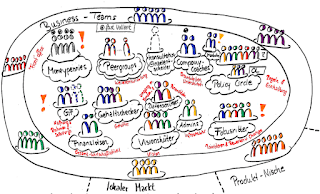I am writing this to share my experience from working at it-agile GmbH. It is not my intention to prove Rich wrong (I am not questioning his experience), but to provide an alternative view on what working at a company with a non-tranditional structure can be like - and what might be necessary to make it work.
Disclaimer: this is purely my personal perspective and opinion. Nobody at it-agile (or elsewhere) approved of this text. I am writing this during my vacation, out of passion for this way of working.
A bit of background: it-agile was founded in 2005 by three colleagues who where unhappy about how they were treated by their boss. Today (July 2018) we are 42 permanent employees, currently growing quickly. About 65 percent of the company is collectively owned by all permanent employees.
I joined it-agile in 2009 and went through a couple of phases since then: excitement, puzzlement, frustration (for halve a year, I seriously considered quitting). Today, I would describe my relationship to my company of choice as mainly dominated by appreciation - for the joys and difficulties of working in such a structure, for being able to be part of such a "social experiment", and for my colleagues, who, despite all our differences, are willing to invest into our shared journey.
In all those years, we learned a lot about how to run a "boss-less" company - and we are still learning. And that's definitely not always fun.
For the rest of this article, I will pick a couple of Rich's tweets that I feel I can provide an interesting alternative or complementary perspective on. I will skip those that are specific to working in a software development team.
So-called “self organizing” companies are controlled by mass anxiety. Anxiety is contagious. I don’t think they are healthy places to work.— Rich Geldreich (@richgel999) 15. Juli 2018
I can see at least two reasons why that would often be the case.
First, if you take away formal hierarchy, it will quickly be replaced by an informal hierarchy. There will always be people who have more influence than others. The company culture will quickly reflect the values in action of those top influencers. And even if they espouse values of cooperation etc., they will have learned tools of coercion that they fall back to when things get rough. They just don't know any alternatives.
A central hurdle is that the tools of coercion actually had an important function: creating "alignment". If you take that tool away without replacing it by alternative structures that fulfill that function, it's very easy to loose cohesion over time - at some point, it might easily feel like anarchy has broken out.
The only working alternative that I am aware of is social pressure, created by "brutal transparency" and shared responsibility. At it-agile, every co-worker can see how I spend company money, and every cent I spent affects the profit share of everyone else. If I do something that seems irresponsible, I will get strong feedback, sometimes in a way that is hard to digest.
If that doesn't sound nice - well, it isn't. It can be very productive, and actually fulfilling, though. For that, we had to invest a lot into acquiring new skills, though - especially skills that help us to deal with conflicts in an effective way. If you don't posses those skills, it's easy to imagine how it would result in a culture of anxiety. (Interestingly, at it-agile it resulted in a culture of false compromises and frustration. So, it doesn't have to be anxiety.)
So, in summary, if you think you get a "self organizing" company by just taking away or reducing the formal hierarchy, I am not at all surprised if you end up with increased anxiety.
If you’re dealing with a self-organizing company it’s more complex. You will be triangulated against multiple people and you’ll have to deal with group consensus.— Rich Geldreich (@richgel999) 15. Juli 2018
True. Navigating (and shaping) the social network becomes a much more important skill when you take away the hierarchy. Personally, I would rather learn this one, than learning how to game the formal hierarchy.
Also, you can put structures and agreements in place to deal with the negative effects of triangulation (aka office politics). At it-agile, we have developed a shared understanding that if we talk about a coworker, we hold each other responsible for then also talking with said coworker about the topic that bothers us.
What you’ll find is that the corporate arm influences, controls, and “anxiety spikes” the self-organizing arm nearly constantly. It’s not self-organizing, it’s a company with opaque managers ruled through mass anxiety and fear.— Rich Geldreich (@richgel999) 15. Juli 2018
Seems that part of the confusion here is that "self organizing" isn't really well defined. (As far as I know, Human Systems Dynamics even argues that every social system is self-organized - in a traditional company, people just self-organize around hierarchical constraints.)
As Niels Pfläging argues much better than I could, flatter hierarchies are not the answer, decentralization is. And it comes with the challenges mentioned above.
A lot of Rich's tweets reference the existence of such a "corporate arm". His advice seems to revolve around how to use that fact for your advantage, or at least survive it. If I'd ever decided to work for such a company, only if I'd see a chance that that "arm" actually would be interested in getting reflected their (negative) impact and change their behavior.
At self-organizing companies with bonuses, workers will watch for rivalries between other coworkers to exploit. They will team up with one dev to bring the other (disliked) dev down a notch in some way. (I’ve seen this several times.)— Rich Geldreich (@richgel999) 15. Juli 2018
There are whole books written about why (individual) bonuses are a really bad idea in today's workplace. That is true doubly so for "self-organizing" companies.
Having said that, a fair compensation structure is a very complex problem to solve, that we haven't fully figured out yet ourselves. I am not even sure that it's possible. We are experimenting with variations of different approaches for years now, and are in constant dialog about it. That's the most important thing for me: I can talk about what bothers me, and I have an impact by doing so. I also understand that what would work best for me, wouldn't work well for everyone of my colleagues.
On a competitive team within a self-organizing company, avoid asking for help unless you absolutely, positively need it. Any information you receive may be purposely distorted in some way. If you do ask for help, gather consensus from multiple devs.— Rich Geldreich (@richgel999) 15. Juli 2018
Putting teams inside the company in competition to each other - another stupid idea that becomes even worse in a self-organizing company.
What you do want, is teams holding each other accountable. A team at it-agile that seems to struggle will get asked "what are you doing to get out of the struggle", but also "what help do you need". A team that does exceptionally well will get asked how they do it - both to learn from it, but also to make sure they don't overwork themselves and steer into burn-out.
If you’re running a self-organizing company, you need to have a measure and understanding of the current average and peak Anxiety Level within the self-organizing arm. Or it blows up and talent walks.— Rich Geldreich (@richgel999) 15. Juli 2018
This is an interesting tweet. I would rather say "if you're running a self-organizing company, what the heck do you mean by self-organizing?" A self-organizing company, by my definition, isn't run by a single person (or small group of people).
Having said that, it's true that it pays to have someone who has an eye on the company atmosphere (which is much more than just anxiety level). In 2016, we introduced the role of a company coach for that (though not just that) purpose. It's a rotating role, that one colleague fills full-time, assisted half-time by another colleague. Remember: these are colleagues who would otherwise be out there making money for our shared profit. And we all decided together that it's worth it.
These folks will be given a free pass. The corporate arm can hire and fire anyone they want at any time. If you went through the normal interview loop and weren’t filled in beforehand, the corporate arm could care less about you.— Rich Geldreich (@richgel999) 15. Juli 2018
After skipping a couple of "corporate arm" tweets, this one stood out for me.
At it-agile, an interview is done by at least four self-selected colleagues. If I have a strong doubt about a hire, I can be part of the interview. And all those colleagues in the interview need to agree to make an offer.
So ironically, the better and more skilled the recruit the less probable it is that they’ll get the job. Current employees don’t want any more competition for their bonuses.— Rich Geldreich (@richgel999) 15. Juli 2018
Interestingly, shared profit has the exact opposite effect: the better the recruit, the more profit he will produce, the bigger my profit share.
If you run a self-organized firm and you have turned up the anxiety levels too high, your company will become brittle and prone to mass talent flight. Wealthy competitors can come in and make offers and basically steal all your tech and devs right out from under you.— Rich Geldreich (@richgel999) 15. Juli 2018
I would emphasize that that can happen to you simply because you don't know how to run a self-organized company. At it-agile, at one point the level of frustration became so high, that we feared if we'd just continue, we all would quit in a matter of two years. And nobody wanted that level of frustration or was willingly benefitting from it.
We took that as a trigger to explicitly invest lots of time and money into learning how to better deal with conflicts. We got professional external help, and created internal roles responsible for supporting the process. And that process still isn't finished, though we have a much better understanding of the necessary skills and processes today, and the working atmosphere and culture has improved considerably. (Interestingly, the year we started investing into this, profit also increased noticably.)
OK, I could write much more, but I am getting tired, and this is already quite longish for a blog post. If you are interested in something specific, I will happily answer your comment. Or, if you read German, you can look at the book that I am very slowly writing on LeanPub: "Wir arbeiten hier trotzdem".




